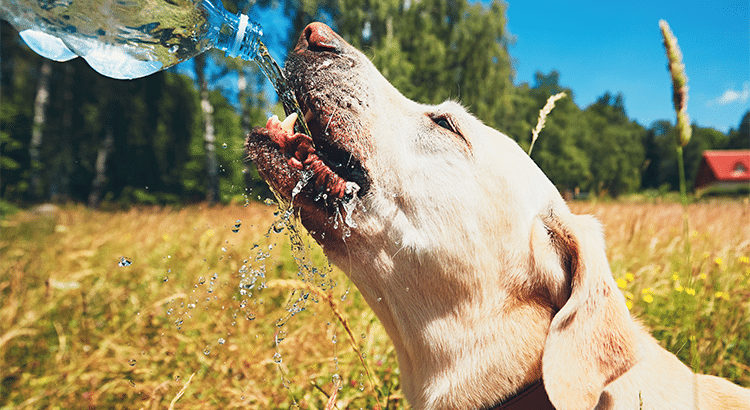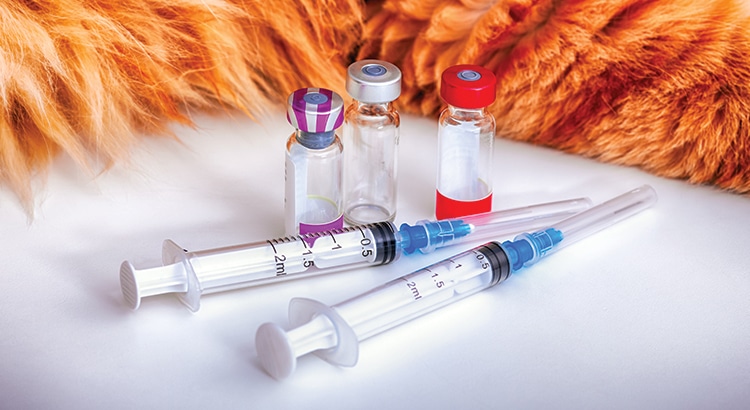
July is National Pet Hydration Awareness Month.
This is no surprise, as July is one of the hottest months of the year. While pups enjoy lounging during the day, it has become apparent during quarantine that they can also get quite bored. With pet parents working from home and more available for puppy play time, an increase in activity can lead to a necessary increased need for water intake to maintain sufficient hydration.
So, whether you are an owner that enjoys taking your pup to doggy daycare, the dog park or on walks around your neighborhood, there is one common denominator: make sure your pup stays hydrated. Here are some tips on maintaining hydration and things to look for should your pup begin to suffer from dehydration.
How to Keep Your Pet Hydrated
Provide Access to Water at All Times– Whether at home, traveling, at the park or on a walk, pets need access to water at all times. It is important for pets to meet their daily water intake requirements for good health.
Know How Much Water Your Pet Needs– Dogs need an ounce of water daily for every pound of body weight. As a pet’s activity level increases, their water needs increase.
Bow Wow Labs Guide:
Dog Weight: Daily Water Need:
5-15 pounds 1-2 cups
15-30 pounds 2-4 cups
30-45 pounds 4-6 cups
45-60 pounds 6-8 cups
60-75 pounds 6-8 cups
75-90+ pounds 8-10+ cups
Bring Water with You– You are your pups source to water access, and therefore should have it with you at all times. Keep a collapsible bowl with you when on the go and a supply of cool, fresh water.
Provide a Place to Cool Off– Pets are unable to cool down very effectively and can burn in the sun, requiring access to shade via a tree, covered patio, sun sail, planter umbrella or dog cot with canopy.
Add Water to Your Pet’s Food– Dry kibble does not offer any type of hydration. Pet parents can add water to dry, canned or homemade food to increase their pets water intake.
Try a Pet Drinking Fountain– Tempt your pet to drink more by providing the chance to drink from a running fountain. This source can also provide filtering to remove any deterring taste or odor.
Provide Multiple Water Bowls– Offer more opportunities for your dog to drink water by including bowls throughout the house including living room, bedroom and outside. The visual cues can also tempt your pup to take a drink.
Make Ice Pops for Your Doggy– “Pupsicles” require only a few ingredients and little prep time. While noting to never give your pup anything that is “sugar-free”, here are a few “pupscicle” recipes.
Wash Water Bowls Often– Some pets are finicky and only want clean water to drink from. Cleaning your pet’s bowl often reduces scum buildup and bacteria, offering a clean water source.
Take Your Pups on Walks During the Coolest Part of the Day– Aside for saving your pups paws from burning on hot concrete, walking them during the early morning or late evening is prime for maintaining their hydration.
Make Sure Water Bowl is Appropriate Size– Once you know your dog’s daily water requirements, you can choose the appropriate size to meet their needs. Elevating the bowl for larger pups will make their life easier.
Conserve Energy– Give your pup a reason to stay inside with their favorite dog chew or playing with a laser pointer. Limit outdoor activities of water hose play or outdoor games until after the sun has gone down.
Go for a Swim– Of course, make sure your pup is a safe swimmer. Get your pup a life vest and choose shallow water if possible. Let your dog choose to get in the water, never throw them in.
Benefits of Pet Hydration
Maintaining pet hydration has many benefits, including physical and psychological gains. Just as their human counterpart, dogs enjoy staying cool which improves their mood and well-being. Water is important to help every body system function efficiently. Physical benefits of hydration include:
Water intake should be increased for dogs who exercise and depending on the environmental temperature.
Know the Signs of Dehydration
Dehydration is caused when pets expel more fluid than what they are taking in. Dogs will naturally lose water all day by sweating through their paws and panting, using the restroom, and can become very sick with the loss of 10-15% of the water in their body.
Signs of Dehydration:
Test of Dehydration: Gently pick up a fold of the pet’s loose skin from between their shoulder blades and see how it recoils back to the original position once released. A well-hydrated dog’s skin will instantly spring back into position. A dehydrated dog’s skin will take longer to its position between the shoulders.
Pet owners should monitor their pet’s activity and water intake to prevent dehydration. In certain cases where dehydration is severe, major organ systems can be at risk of failure and immediate veterinarian assistance may be required. Re-hydration must be slow and the vet will likely choose intravenous fluids. Also contact your vet if your pet does not want to drink water for extended amounts of time.
Problems with Severe Cases of Dehydration:
Should you suspect your pet is suffering from dehydration, contact your veterinarian and ask for recommendations to improve their water intake. Pin Paws offers a plan that includes whiskerDocs providing vet access via phone, chat, email or video 24/7 in the event you need advice and support after hours. Click here to learn more about our Pin Paws Plus membership.




